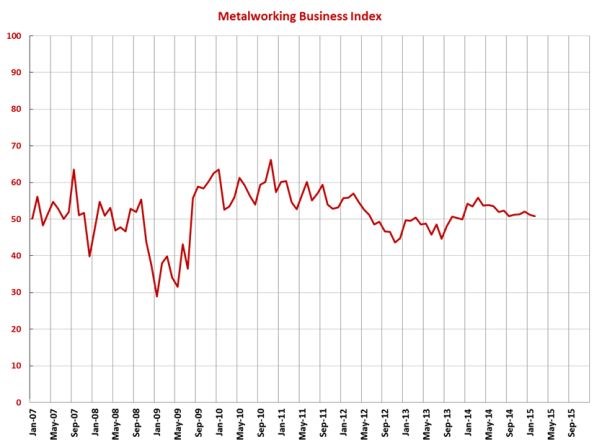February MBI Shows 14th Month of Industry Growth
With a reading of 50.8, the Gardner Business Index showed that the metalworking industry grew for the 14th consecutive month and the 16th time in 17 months.
Share







With a reading of 50.8, the Gardner Business Index showed that the metalworking industry grew for the 14th consecutive month and the 16th time in 17 months. The MBI increased from September to December 2014, but in the first two months of 2015 the index moved slightly slower. Overall, the index has been relatively flat since the summer of 2014. For the second month in a row, the index was about 5 percent lower than it was one year ago.
Both new orders and production increased for the 17th month in a row. Since September 2014, the new orders index trended up slightly. Production was on a similar trend, but fell off significantly in February. Backlogs continued to contract. In fact, the index was at its lowest level since September 2013. Compared with the same month one year ago, the backlog index contracted by more than 11 percent for the second month in a row. The annual rate of change decelerated for six months in a row, which indicates that the rate of growth in capacity utilization will peak any month now. Employment was still increasing, but the index was at its lowest level since December 2013. The dollar continued to strengthen against almost every other currency. Therefore, exports continued to contract at a significant rate. Supplier deliveries lengthened at their fastest rate in nearly three years.
Material prices increased at a somewhat faster rate than the previous month. However, the rate of increase was still virtually the slowest in the last two years. Prices received increased at a pretty steady rate for the last 10 months. Future business expectations improved slightly from January. The expectations index was near its peak level since the summer of 2012.
Plants with more than 250 employees expanded at a significantly slower rate in February. It was the second lowest rate of expansion since December 2013. These large plants were the prime reason for the slower growth in the metalworking industry, as all other plant sizes had fairly stable business conditions in February. Plants with 50 to 249 employees continued to grow at a good clip. Shops with 20 to 49 employees expanded for the second time in three months. Shops with fewer than 20 employees continued to contract at a rate similar to the last nine months.
The North Central – East was the fastest growing region for the second month in a row. This region is heavily dominated by the automotive industry. It was followed by the West, North Central – West, and Southeast regions. The Northeast contracted for the second month in a row. And, the index in the South Central continued to fall.
Future capital spending plans contracted 4.5 percent compared with February 2014. This was the slowest month-over-month contraction in the last five months. The annual rate of growth contracted for the third month in a row.
More economic news from Gardner Business Media can be found here.
Related Content
-
Metalworking Activity Contracted Marginally in April
The GBI Metalworking Index in April looked a lot like March, contracting at a marginally greater degree.
-
Optimism Grows as Metalworking Index Improves Again in November
A sharp increase in future business expectations underscores hopeful conditions in 2025.
-
Metalworking Activity Trends Downward in May
Accelerated contraction and declines in business optimism span manufacturing segments. Odds are that broad-reaching economic factors are at play.

.JPG;width=70;height=70;mode=crop)
















.jpg;maxWidth=300;quality=90)





